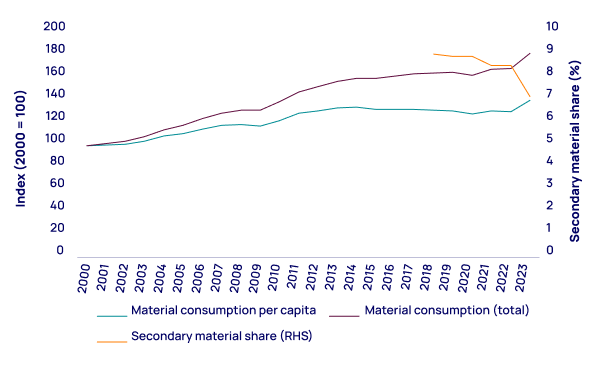Circular economy not fulfilling promise

The circular economy, a critical strategy for delivering a lower-emission, more sustainable future by reusing materials and minimising waste has made disappointingly little impact on the global plastics industry in the last decade as it struggled to navigate traditional value chains and business practices according to a new report by Wood Mackenzie.
The July Horizons report: ‘Waste to wealth: Unlocking circular value chains’ states that despite the rising tide of corporate commitments and regulatory targets, progress of the circular economy model has been extremely slow. While there are profits to be made in circular value chains, the fundamental problem remains ensuring these are shared fairly across complicated, fragmented value chains.
“The circular economy model has not made the impact many plastics industry observers predicted when it was first mooted, but there are some exciting initiatives underway that could change that,” says Guy Bailey, Vice President of Oils & Chemicals Research at Wood Mackenzie. “The successful negotiation and introduction of the United Nations Plastic Treaty [a legally binding agreement that would end plastic pollution] is a necessary starting point, but the adoption of new business models to drive coordination across the value chain is the key to real change.”
The report states that currently petrochemical companies, technology companies and waste management firms all operate with different assumptions about what a ‘fair’ allocation of value looks like. Without a route to profitability for all value chain participants, the result is slower than anticipated technological adoption and investment in the necessary waste infrastructure. The report adds with so much added complexity in circular economy value chains, commodity-producing firms – such as the petrochemicals sector – must step up to the mark and help drive the necessary coordination and collaboration through the adoption of novel business relationships.
These frameworks include partnerships which are suitable for less complex projects and offer companies the chance to retain autonomy; joint ventures which are more suited to strategic projects needing specialist market knowledge and vertical integration which involves acquiring suppliers and distributors to maintain complete control of a project.
The report concludes by making a series of recommendations to ensure that the circular economy model overcomes its initial teething troubles and lives up to the hype that has built up around it as a genuine economic system that actually works.
The recommendations include changing strategic thinking to include how to bring about the value chain transformation needed for success; encourage investors to acknowledge the long-term benefits of first mover status in circularity exceed short-term dilution of profits and for stronger relationships are built with brands to ensure that the complex value chains required are created.
“The journey to full circularity has not got off to an ideal start,” Bailey concludes. “But with clear and consistent regulation and creative collaboration then the circular economy model can still provide an effective solution to reducing waste and lowering carbon emissions.”
标签:



热点文章
2025“蓉漂杯”高层次人才创新创业大赛海外重点区域专项赛(法国赛区)圆满收官
百神药业十年上市路撞上医药反腐,高特佳押注失算?
蔚来汽第一季度营收106.8亿 预计二季度车辆交付量下降
“佛喜茶”联名翻车,会影响喜茶后续上市吗?
刘元春:今年中国经济增速达到5%左右的目标没有问题
田华:制造业、服务业和数字经济等成为经济发展的重要引擎
李佳琦:你不是“下一个李佳琦”,你就是你自己
游客水库边露营拒付100元费用,村民喊来撒粪车浇地,管理方回应